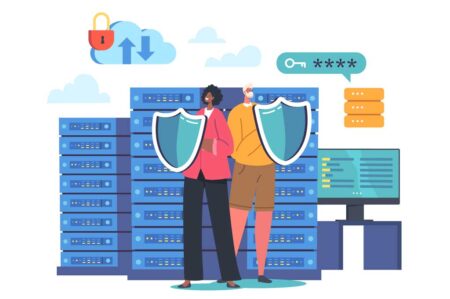There’s a misconception that hackers only target big businesses. While it’s true that the majority of cyberattacks occur with large-scale companies, 43% of attacks are directed at small businesses.
Do you have a strategy in place designed to protect your website in the event of a cyberattack? If not, you could risk losing time, money and, most importantly, the trust of your customers.
There’s a common misconception that hackers only target big businesses. While it’s true that the majority of cyberattacks occur with large-scale companies, a surprising 43% of attacks are directed at small businesses.
Why?
Simply put, small businesses are usually not prepared to handle the issues that come up when a hacker attempts to break in from multiple angles. You’ll be happy to know that there are steps you can take to prepare your business for cyberattacks, regardless of your company size and budget. However, there are five low-cost tips that business owners can implement today to improve their website’s security.
Audit your website.
The first thing you should do is run a security audit on your website. Ideally, you’ll want to run an audit every quarter to look for suspicious behavior and red flags alerting you to potential security threats. Some of the signs you’ll want to look for include:
- A dramatic difference in page loading times
- Unexplained increase or decrease in traffic
- Phony links and accounts
We suggest checking your content management system (CMS) for core updates. The most popular CMS is WordPress, but your platform likely has a frequent update schedule. If you’re not regularly installing patches, you could open your site up to harmful attacks.
Next, go to your page with user credentials and look for anything out of the ordinary. For instance, if you have an e-commerce website, you likely have tons of different users, because people need to make accounts to buy products. But if you’re only running a blog, you should be able to quickly identify all of the users. If you notice new accounts or strange changes to existing accounts, take a closer look for fraud.
Finally, don’t forget to review your page and user analytics. Look for suspicious behavior, such as multiple accounts visiting from the same IP. Keep an eye, too, on pages that allow for user-generated content. Scammers use these portals to get in the back door of your website.
Use a reputable hosting company.
You can’t have a great website if you don’t have a good hosting provider. Ideally, hosting companies should focus on speed, performance and security. There are plenty of options to choose from if you’re creating your first website, but there are some important considerationss you should be aware of about how hosting directly impacts security.
Never, under any circumstance, use “free” hosting. You’ll see offers for free hosting in exchange for a banner ad or text on your footer. The concern with free hosting is you may not have control over the performance and security aspects of your provider. Or, the person who offered the free solution can change their mind and remove your site at any time.
For an optimal, low-cost security experience, start with a shared hosting option. In most cases, these providers will take good care of your site behind the scenes, which reduces the chance of a cyberattack.
Once your business grows, and you’re getting over 25,000 visitors every month, you may want to upgrade to a managed or dedicated hosting provider.
Make multifactor authentication a security cornerstone.
You’ve likely noticed how websites like Facebook, YouTube and Gmail give users the option to set up multifactor authentication. Essentially, this strategy is designed to protect accounts from getting hacked. It’s no longer enough for a user to enter their password and click Log In.
People can now add their phone number, alternate email account or access code with their password. The result is that users can keep their accounts locked down, because hackers need the other piece of the puzzle to log in.
If you’re not using multi-factor authentication, you’re opening your website up to potential threats. You can add multifactor authentication to your website for free. Once it’s set up, if someone uses a brute force attack to crack a password, they still likely won’t be able to access sensitive information.
Keep your plugins updated.
Plugins are essential additions you can add to your site to create contact forms, promote your products, improve the user experience and much, much more. On WordPress alone, there are over 50,000 options to choose from.
Due to the sheer volume of these tools, it’s not hard to see why some can pose a security risk to your website. When reviewing security data, it was discovered that 52% of all security vulnerabilities stem from plugin use.
These additions aren’t bad for your business; however, think carefully about the plugins you add to your site. Look for user reviews, potentially adverse interactions with existing plugins and the reputation of the developer.
Also, keep your plugins up to date. Reputable companies frequently update their plugins to make it more secure for your site and add new features for consumers.
When you decide on the core list of add-ons you need for your site, check for weekly updates to make sure you’re always using the newest and safest plugin version.
Create multiple backups.
Thus far, the tips offered can help keep your site secure, but no strategy is foolproof. Hackers are developing sophisticated bots and strategies to break through traditional security methods. If your website falls victim to a hack or malware, you don’t want to compromise user data, all of your blog content and the site that you worked so hard to build.
Backing up your website gives you peace of mind knowing that you can quickly and easily restore your site if something goes wrong. Ideally, you should create multiple backups of your site regularly, and keep each one in a different place.
The goal is to have a full shield of protection from all cyberattacks. Backups are a great way to get your site up and running, which reduces the chance of the attack causing irreversible damage.
As new types of cyberattacks come to life, business owners need to prepare. If you’re on a limited budget, you can start implementing these tactics for free or in some cases, for a small fee.
There are plenty of places in site design and maintenance where cutting corners is acceptable and even preferred. Business owners, developers and IT experts agree that security is not one of those areas. You need to have a robust security plan in place that’s ready to take out ambitious scammers looking to capitalize on your hard work.


